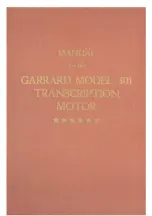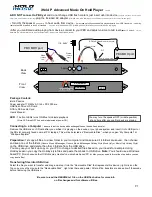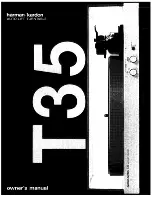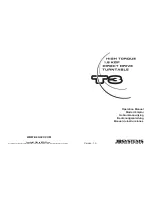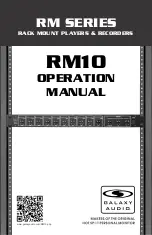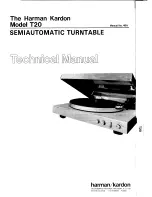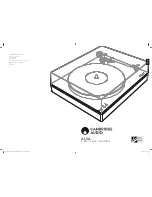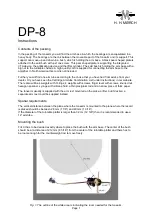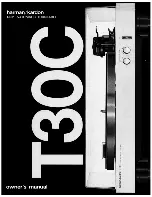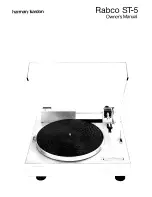
Audio Specifications
4.0.1 Magnitude Response
The magnitude response
of any audio
device is a measure of how much its
output level deviates from the
expected level at di
ff
erent frequencies.
In a turntable, this can be measured in
di
ff
erent ways.
In the case of the Beogram 4000c, the
frequency response is measured from
a standard test disc with a sine wave
sweep ranging from at least 20 Hz to at
least 20 kHz. The output level of this
signal is recorded at the output of the
device, and the level is analysed to
determine how much it di
ff
ers from the
expected output. Consequently, the
measurement includes all components
in the audio path from the stylus tip,
through the RIAA preamplifier, to the
line-level outputs.
4.0.2 Rumble
In theory, an audio playback device
only outputs the audio signal that is on
the recording without any extra
contributions. In practice, however,
every audio device adds signals to the
output for various reasons. As was
discussed above, in the specific case of
a turntable, the audio signal is initially
generated by very small movements of
the stylus in the record groove.
Therefore, in order for it to work at all,
the system must be sensitive to very
small movements in general. This
means that any additional movement
can (and probably will) be converted to
an audio signal that is added to the
recording.
This unwanted extraneous movement,
and therefore signal, is usually the
result of very low-frequency vibrations
that come from various sources. These
can include things like mechanical
vibrations of the entire turntable
transmitted through the table from the
floor, vibrations in the system caused
by the motor or imbalances in the
moving parts, warped discs which
cause a vertical movement of the
stylus, and so on. These low-frequency
signals are grouped together under the
heading of
rumble
.
A rumble measurement is performed
by playing a disc that has no signal on
it, and measuring the output signal’s
level. However, that output signal is
first filtered
to ensure that the level
detection is not influenced by
higher-frequency problems that may
exist.
If the standard being used for the
rumble measurement is the DIN 45 539
specification, then the resulting value
is stated as the level di
ff
erence
between the measured filtered noise
and a the standard output level,
equivalent to the output when playing
a 1 kHz tone with a lateral modulation
velocity of 70.7 mm/sec.
4.0.3 Rotational speed
Every recording / playback system,
whether for audio or for video signals,
is based on the fundamental principle
that the recording and the playback
happen at the same rate. For example,
a film that was recorded at 24 frames
(or photos) per second (FPS) must also
be played at 24 FPS to avoid objects
and persons moving too slowly or too
quickly. It’s also necessary that neither
the recording nor the playback speed
changes over time.
A phonographic LP is mastered with
the intention that it will be played back
at a rotational speed of 33 1/3 RPM
(Revolutions Per Minute) or 45 RPM,
depending on the disc. (These
correspond to 1 revolution either every
1.8 seconds or every 1 1/3 seconds
respectively.) We assume that the
rotational speed of the lathe that was
used to cut the master was both very
accurate and very stable. Although it is
the job of the turntable to duplicate
this accuracy and stability as closely as
possible, measurable errors occur for a
number of reasons, both mechanical
and electrical. When these errors are
measured using especially-created
audio signals like pure sine tones, the
results are filtered and analyzed to
give an impression of how audible they
are when listening to music. However,
a problem arises in that a simple
specification (such as a single number
for “Wow and Flutter”, for example)
can only be correctly interpreted with
the knowledge of how the value is
produced.
Accuracy
The first issue is the simple one of
accuracy: is the turntable rotating the
disc at the correct
average
speed? In
the Beogram 4000c, this speed is
governed by a tachometer built into
the drive motor, that (like on almost all
turntables) can be adjusted by the user
using the controls shown in Figure
These adjustments allow for a usable
range of
±
3%, which in music terms is
equivalent to
±
half of a semitone.
Figure 4.1: The fine adjustment controls
for the 33 1/3 and 45 RPM settings.
Stability
Like any audio system, regardless of
whether it’s analogue or digital, the
playback speed of the turntable will
vary over time. As it increases and
decreases, the pitch of the music at
the output will increase and decrease
proportionally. This is unavoidable.
Therefore, there are two questions that
result:
1
This is the correct term for what is typically called the “frequency response”. The di
ff
erence is that a magnitude response only shows output level vs. frequency, whereas the
frequency response would include both level and phase information.
2
The characteristics of the filters are defined in internal standards such as DIN 45 539 and IEC98-1964.
14




















